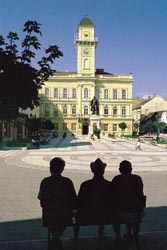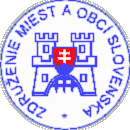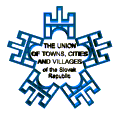
History
Komárno is a town at the confluence of the
rivers Danube and Waag at a sea-level of
108-115 m. It is an ancient settlement of the Carpaths basin and
a town of a very rich historical past. The territory has been inhabited since
the early Bronze-period. First the Celtes had settled here and nearby on
the left shore of the river Danube the Romans have established a Legion-Camp
known under the name of Brigetio and so was the town itself established
by them. In the migration period the Avars have stayed here for longer
time. After the Magyars Conquest at the mouth of the rivers Danube and
Waag a fortified castle had been built. Komárno became a county
residence following the governments organization. Beside this fortified
castle a settlement of indentical nomination had been established too.
The gone by towns had acquired some privilige from the King Adalbert IV.
in 1265.

|
|
|

On the place of the middle aged fortress
another fortress had been erected against
the Turkeys. That fortress bore the name Old Fortress. And
this was enlarged under the region of Leopold I. named New Fortress.
In the 18. century it had been the
centre of the guild industry too. In 1745 Maria
Teresia raised Komárno for a Royal Priviliged town. In the years 1763, 1783
Komárno was the place of terrible earth?quakes. As an effect of the Napoleon
Wars the Vienna Court decided the rebuilding of the fortress to make
it possible forstationing 200 thousend soldiers and that time it was a reliable
strong fortress system. The rebuilding of the fortress ceased in continuing
because of the Hungarian Independent wars.
In 1848 the Great Fire ruined the town
completely. Next year the ravage continued by the empires canons
nad army. The defender of the town was Georg Klapka who resisted the ennemy,
but after so many battles the town was in ruines.
In the seventhy years of the 19. century the
building of the fortress was completed but the town
because of the chain of fortifications caused its decline. Only in the 19.
century began the developping agan. That was mainly therefore, because Újszőny
was joined to Komárno being situated on the side of the Danube. Now there
was space for expanding.
In 1919 right the left side of the river together
with Komárno was joined to the Czechoslowak Republik an became a border
town of the Republik. In November 1938 according to the Vienna first decision
Komárno was joined to Hungary.
Presently it is a district residence with 38
000 inhabitants with remarkable machine industry, it posseses a ship yard
a bright tourists traffic and with a vivid cultural life. Two third of the
inhabitants are of Hungarian nationality and like that it has become one
of the cultural centre of Hungarians living in
Slovakia.
Homepage: www.komarno.sk

|









